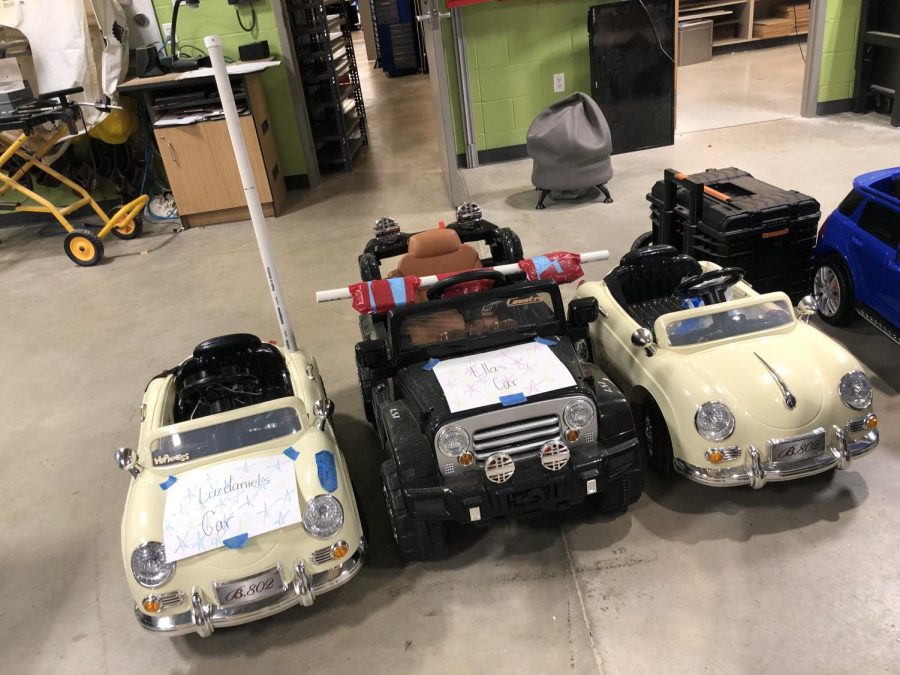Engineering class helps kids drive toward independence
Students, working with Illinois Spina Bifida, make small cars for children
Appel
Intro to Engineering students have completed the early designs, which include a pre-mounted feeding tube
Toddlers from ages 2-5 with Spina Bifida are often paralyzed from the waist down. For their final project, Intro to Engineering is modifying and rewiring small, one seat cars these children can drive indoors. Students will spend weeks, including weekends, helping these children boost their independence.
SILC Elizabeth Walther has helped organize much of the project, and is very happy with its progress.
“We try not to hand-hold the students while they work on the project,” says Walther. “It is important to us that they are learning valuable skills while also helping make a difference in the lives of those in our community.”
Engineering students were given small cars they had to rewire. This included adding a kill switch to the back, and an accelerator that could be pressed with the driver’s upper body, whether that’s a button on the steering wheel or behind the driver’s head.
“For example, one of the children we are working with uses a NG (feeding) tube, so we have pre-mounted a stand to the back of their car to hold their food bag while they drive around,” says Walther.
Engineering teacher Nathan Silvers said how important it is to prevent learned helplessness. This is when the parents of the toddlers who cannot move easily do simple things for them, and it harms their development.
“We bring them the toy to make them happy, and they don’t think that they can navigate their environment,” says Silvers. “They’re not really helpless, but they think they are.”
While the kids cannot achieve certain movements, students are working to give them the independence to move around themselves, which can add both responsibility and freedom in their lives.
This is the first year the class is working with Illinois Spina Bifida. They have worked on some of the more simple designs, but these still involve major modifications to the cars.
“As we gain our experience, they’re going to start giving us some of the harder projects,” says Silvers. “Sometimes, they may not be able to sit up at all, so we’d have to build a roll cage around them to help sit up correctly.”
While the school is giving these cars to Illinois Spina Bifida to distribute, this idea was started through Go Baby Go, which also works with the AbilityLab in Chicago and Shriners Hospital. They are a group that has many chapters throughout the country, each aiming to give children more control over their lives.
“Beyond mobility and socialization, we hope that the ride-on cars provide children with disabilities a chance to just be a kid,” states their website. “Being pushed in a stroller or being carried from one place to another is fundamentally different from having active control over one’s own exploration.”
Insurance limitations often stand in the way of kids gaining access to these cars. There aren’t any commercially available devices to help those with mobility issues move about. According to Walther, It’s critical these children get mobility devices before preschool, but insurers often settle for something closer to a stroller.
“When their teachers realize that they are smart enough to learn powered mobility, the insurance company will refuse to pay for an electric wheelchair because they just spent thousands of dollars on the stroller,” says Walther. “In effect, the kids are denied independence.”
Many of the specific modifications for each individual recipient haven’t been made yet. The children will test out their cars at New Trier on Saturday, May 29. Students will spend the entirety of the day modifying and fixing the designs so that they can be delivered to Illinois Spina Bifida.
“We’re probably going to be here from 6 AM until 9 at night fitting these cars,” says Silvers. “It’s a long process and it’s going to be a really cool experience for these guys to be involved in.”









































